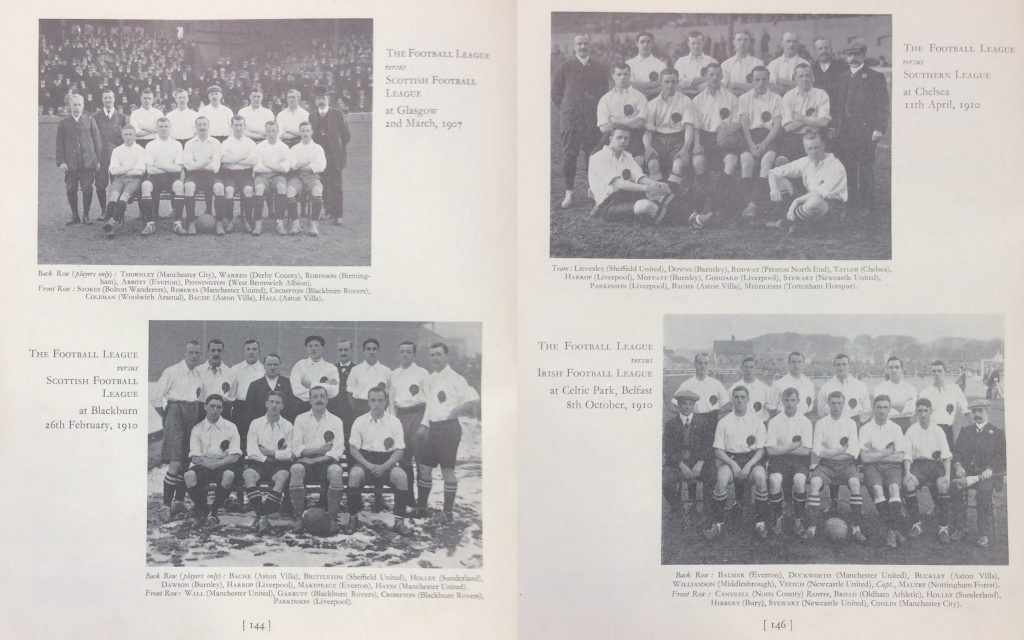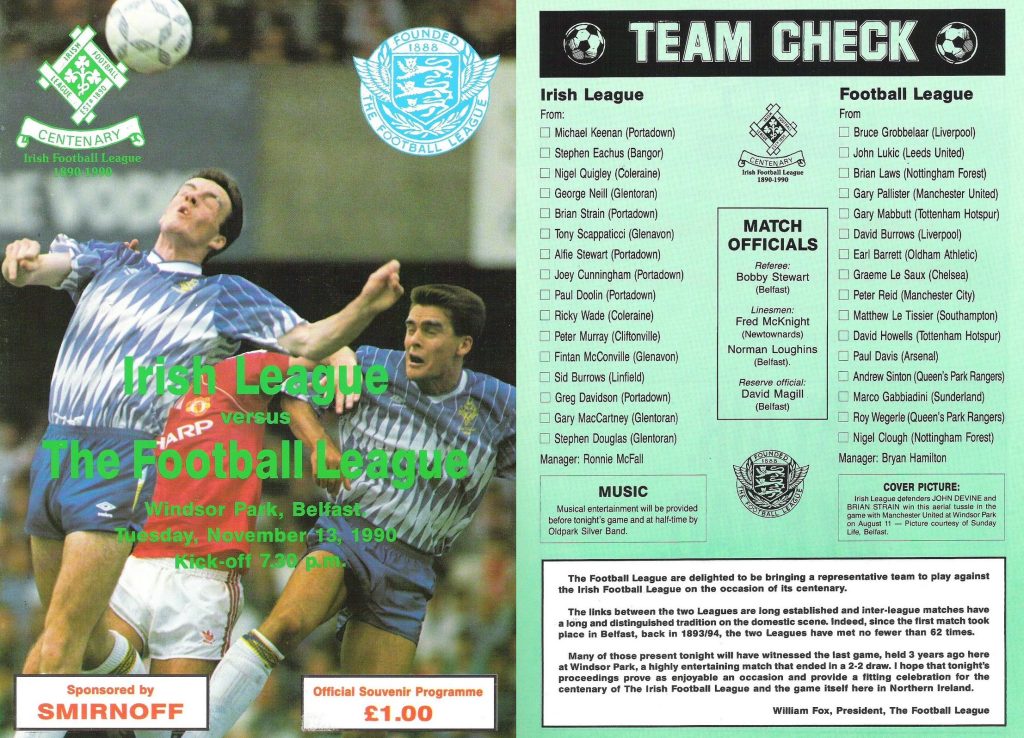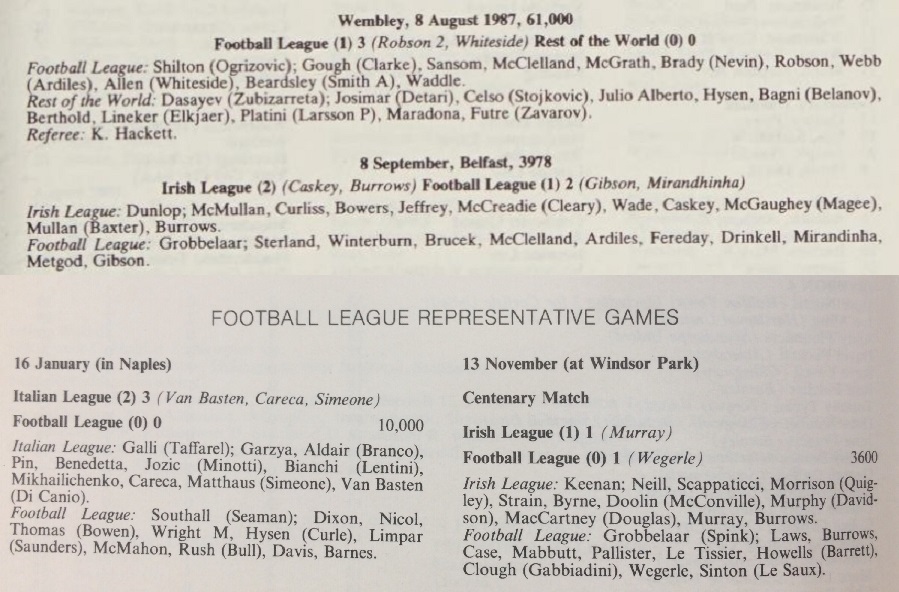Inter-League Matches: A Century of Football League Fixtures 1891- 1991
Inter-league matches were introduced in the very first set of rules published by the Football League in January 1889: “A match shall be played each season between teams selected by the Management Committee of the League, the proceeds of which shall be devoted to the funds of the League.” After many years in which they were a vital money-raiser, a century of inter-league fixtures played by a Football League representative side was completed in Naples in January 1991.


The first match was played against the rival Football Alliance, at Sheffield’s Olive Grove in April 1891. It ended 1-1 but more importantly, the League benefitted from 60% of the receipts from a 6,000 crowd. Everton’s Edgar Chadwick was the League representatives’ first goalscorer. The Story of the Football League relates that the side “included no fewer than six Scots and one Welshman. The players on that occasion were paid a guinea each, with third-class railway fares, and apparently they had to provide their own food and transport out of the allowance.”
The following year, the opening meeting with the Scottish League took place at Pikes Lane, Bolton (site of the first-ever goal in the Football League). This match was also drawn, 2-2, with several Scots again representing the Football League. After this, the League resolved to select only English-born players – a regulation that remained in effect until the 1960s. The return fixture in 1893 at Celtic Park saw the Football League record its first success with a 4-3 win.


It was immediately obvious from these early fixtures that they were going to provide the Football League’s single biggest source of income – the April 1893 return match with the Scottish League in Glasgow brought in more than the League’s combined takings for the year. The Scottish League fixture in particular continued to generate invaluable revenue for decades to come, up until the Second World War. Looking to capitalise on the Scottish encounters, the Football League side travelled to Belfast for its first meeting with the Irish League in February 1894. This soon became another annual fixture, and the matches against their Scottish and Irish counterparts effectively sustained the Football League into the twentieth century.
Once the side was established, a variety of venues hosted Football League matches, from Bradford’s Valley Parade to Oldham’s Boundary Park, to the ‘lost grounds’ of Manchester (Bank Street and Hyde Road) and London (Plumstead’s Manor Ground, once the home of Royal Arsenal). Inter-league games typically took place on a Saturday afternoon, until switching to midweek in the 1930s – despite opposition from the other home nations – with a fall in attendances. A 1934 inter-league meeting noted that Football League clubs were “generally not prepared to release their players on a Saturday owing to the vital nature of their own League Competition”.


In 1910, after years of dispute, the Football League agreed to play representative fixtures against the Southern League. Two matches were played that year in London (at Stamford Bridge and White Hart Lane), and the leagues then met annually up until the First World War. The Football League side continued to operate during the Second World War, travelling the country to play against Army teams and the All-British XI. It was only after 1945 that the idea of playing opponents from outside the British Isles became a possibility, and the League of Ireland was added to the League’s regular opposition from 1947. The first ‘foreign’ fixture took place in May 1953 against a Danish XI – the League winning 4-0 in Copenhagen.
In 1960, the Football League side travelled to Milan to meet an Italian League XI for the first time and lost 4-2 at the San Siro. They were to meet four times until 1964, in which time the Serie A representatives also played the Scottish League twice. Those fixtures showcased the cosmopolitan flavour of Italian football, with players such as Kurt Hamrin (Sweden), Helmut Haller (West Germany), Harald Nielsen (Denmark) and Luis Suárez (Spain) featuring in contrast to the home-grown Football League sides of the day – which increasingly were used as a ‘shadow’ national team squad. The Italian League were also able to call on British imports in John Charles, Gerry Hitchens and Denis Law. Hitchens (playing alongside Law) actually scored for the Italian XI in a 2-0 win at Old Trafford in 1961, and Charles got both goals a year later as the Football League won 3-2 for its only victory against the Italian League. However a small piece of history was made in 1960 with the selection of Manchester City’s German goalkeeper Bert Trautmann, the first foreign player to represent the Football League.


By the 1960s at least, income from other sources – notably television – had begun to replace the receipts once generated by inter-league matches (some of which were televised in the 1950s and 60s). They continued to serve a function, with Alf Ramsey using his selection of the Football League side to shape the future World Cup-winning team ahead of the summer of 1966. Later that year, the League registered its biggest win in the history of inter-league fixtures with a 12-0 win over the Irish League at Plymouth’s Home Park – West Ham’s Johnny Byrne scored four, playing alongside team-mates Moore, Peters and Hurst. Several World Cup winners were also in the team which played the Belgian League in September 1967, drawing 2-2 at the Heysel Stadium. That was to be the League’s last trip abroad until 1991.
Inter-league matches continued into the 1970s, with the Scottish League remaining the primary opposition in latter years. By then, as described by Simon Inglis, the Football League’s fixtures “were now an irrelevance, no more than a toning-up exercise for the national team”. Maine Road was the last English venue for an emphatic 5-0 win for the Football League over their Scottish counterparts in March 1974. Two years later the final meeting of the two took place at Hampden Park, and at the same stadium a Glasgow XI beat the English League’s representatives 2-1 as part of the Queen’s Silver Jubilee celebrations in May 1977.


Below: inter-league match programmes 1948-77


A decade after that fixture, the Football League side was unexpectedly revived for another anniversary, the League’s Centenary. The challenge match at Wembley in 1987 against a Rest of the World selection saw Diego Maradona in action and Michel Platini make his farewell appearance. Only a month later, in September 1987, the League side returned to Windsor Park for the first time in 20 years to face the Irish League. Newcastle’s Brazilian striker Mirandinha became the first foreign player to score for the League XI in a 2-2 draw. That appeared to be the end of the inter-league fixtures, until another draw at Windsor Park (1-1) over three years later in November 1990 to celebrate the Irish League’s Centenary year. South African-born US striker Roy Wegerle was the scorer of the last goal recorded for the Football League side, managed for that fixture by Northern Irishman Bryan Hamilton.


It was the game at Naples’ Stadio San Paolo in January 1991 that saw the final curtain drawn on 100 years of Football League representative matches. The televised fixture against the Italian League took place nearly 27 years after being last played in May 1964. At a venue which had hosted a World Cup semi-final the previous year, two sides full of star names only attracted a crowd of 18,000. The League side was picked by Lawrie McMenemy, including a return to Italy for Ian Rush, John Barnes, Neville Southall and David Seaman alternating in goal, and a pair of Swedes in Glenn Hysén and Anders Limpar. The Italian side was too strong, running out 3-0 winners with Marco Van Basten, Careca and Diego Simeone the scorers, and also able to call on Brazilians Aldair and Branco, Paolo Di Canio, Gianluigi Lentini, Lothar Matthäus and Alexei Mikhailichenko.
As abruptly as they had returned in 1987 inter-league matches were abandoned after the game in Naples, and the Premier League arrived soon after in the summer of 1992. While the Football League has since played against Italian sides with lower-level under-21 representatives, there seems to be no room in the top division’s money-making schedule for further inter-league fixtures.

I am grateful to Shahan Petrossian of Soccer Nostalgia for help with research materials for this article. Several match programmes courtesy of Miles McClagan (Flickr & twitter @TheSkyStrikers).

Above: Football League inter-league results 1890s-1900s
Below: Football League inter-league results 1987-1991
